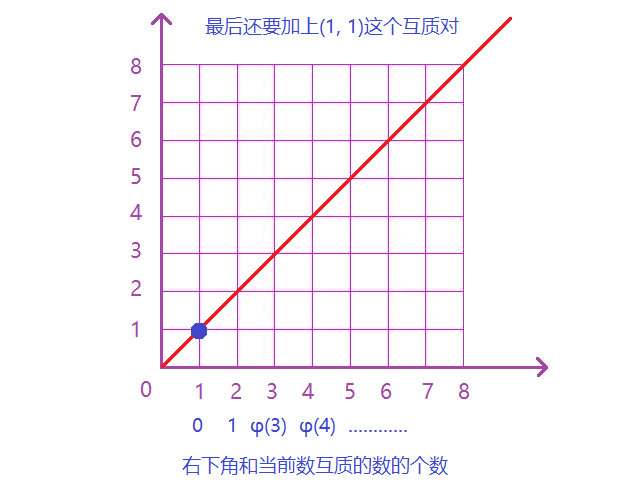分析
-
如果$(x, y) = p$,且
p是质数,则$(\frac{x}{p}, \frac{y}{p})=1$,说明$\frac{x}{p}, \frac{y}{p}$互质,令$a =\frac{x}{p}, b = \frac{y}{p}$,则相当于问在$1 \le a, b \le \frac{n}{p}$的条件下,互质的点对个数。和AcWing 201. 可见的点求解的内容很类似。 -
对于
1~n中所有的质数,都需要求互质点对的个数,下面考虑对于某一个质数p,如何求解,如下图:

-
因此如果令$\phi(1)=0$,则对于对于当前考察的质数
p,符合要求的点对数目为:$2 \times (\phi(1) + \phi(2) + … + \phi(\frac{n}{p}) + 1$。 -
我们需要对于
1~n中所有的质数计算上述表达式,最后相加,因此可以采用前缀和思想求解。
分析
#include <iostream>
using namespace std;
typedef long long LL;
const int N = 1e7 + 10;
// 1e7的int和bool数组大小都为40MB,LL数组大小80MB,因此使用存储空间为200MB
int primes[N], cnt;
bool st[N];
int phi[N];
LL s[N];
void init(int n) {
// 默认phi[1] == 0
for (int i = 2; i <= n; i++) {
if (!st[i]) {
primes[cnt++] = i;
phi[i] = i - 1;
}
for (int j = 0; primes[j] * i <= n; j++) {
st[i * primes[j]] = true;
if (i % primes[j] == 0) {
phi[primes[j] * i] = phi[i] * primes[j];
break;
}
phi[primes[j] * i] = phi[i] * (primes[j] - 1);
}
}
for (int i = 1; i <= n; i++) s[i] = s[i - 1] + phi[i];
}
int main() {
int n;
cin >> n;
init(n);
LL res = 0;
for (int i = 0; i < cnt; i++) {
int p = primes[i];
res += s[n / p] * 2 + 1;
}
cout << res << endl;
return 0;
}

